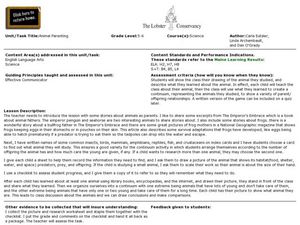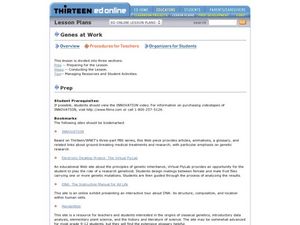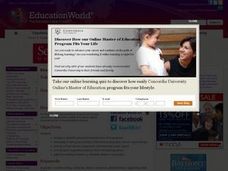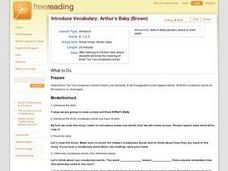Alabama Wildlife Federation
Wildlife Habitat Checklist
Take a walk on the wild side with a project about animal habitats. After kids observe a chosen animal in its home, they describe the animal's food and water sources, shelter, and how it raises its young. They then write a short fictional...
Curated OER
Beanie Friend Vacation Stories
Students write an adventure story about their vacation with a Beanie friend. They select a city, research its vacation possibilities and write about the places that they would like to visit.
Curated OER
Parent and Baby Lookalikes
Students research baby animals, their special names and the vocabulary to describe their relative sizes through discussion, listening to a Salish story, looking at pictures, and creative artwork . They will also explore the significance...
Curated OER
Animal Parenting
Students analyze parenting instincts. For this parenting instincts lesson, students view a drawing of animal they studies and describe what they learned about the animal. Students teach the class about their animal and the class creates...
Curated OER
A Look At Penguin Life
Students read a story about Penguin Life and answer vocabulary and comprehension questions about it. In this penguin life lesson plan, students respond to literature by researching penguins and creating a Venn diagram to compare/contrast...
Curated OER
Introduce Vocabulary: Arthur's Baby (Brown)
Many of your youngsters have experienced a new baby coming home, and Marc Brown's story Arthur's Baby is a relatable way to cover some new vocabulary terms. Introduce and define the new words before reading the text aloud: adorable,...
Curated OER
Do Tigers Like Monkeys?
In these reading comprehension worksheets, 1st graders read the story about a tiger and monkey. Students then answer 5 reading comprehension questions.
Curated OER
Animals and Environments
Students listen to stories and identify animals and their young. In this animals lesson, students view videos about farm animals and create illustrations to show how animal babies change over time. Students discuss how they care for...
Curated OER
Dinosaurs
Students are introduced to the various types of dinosaurs and write in their journals about their favorite one. After listening to a story and watching a filmstrip, they color a few pages in their Dinosaur Friends Book. They also examine...
Curated OER
A PRICELESS Collection
Young scholars read a story about the life of Russian plant breeder Nikolai I and Vavilov and the national seed bank he established. They research the Irish Potato Famine of the late 1840s and identify the cause for this famine and make...
Curated OER
Genes at Work
Students explore and discuss genetics stories and answer questions about genetic outcomes of offspring. In this genetics instructional activity, students read genetics stories on a web site. Students use a chart to answer questions...
Curated OER
Beanie Baby Biographies
Learners write a biography for their favorite Beanie Babies and then share their biography out loud. A simple, yet effective idea! Everyone loves their Beanie Baby!
Curated OER
Introduce Vocabulary: Arthur’s Baby
Students discover the meaning of tier two vocabulary words. In this vocabulary lesson, students read Arthur's Baby, listening for 3 pre-selected, tier two vocabulary words. Words are defined by the teacher and students practice...
Curated OER
Graph Those Stickers!
Young scholars graph fruit. In this graphing lesson students create a graph using fruit label stickers. Young scholars place a sticker on the graph when the fruit has been consumed.















